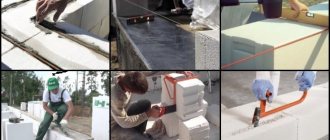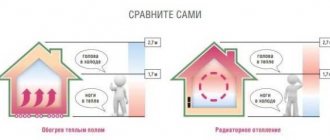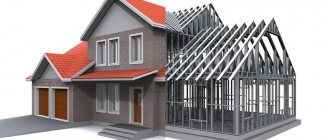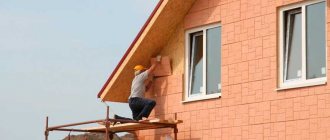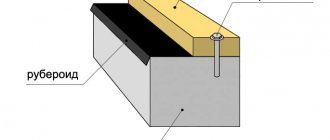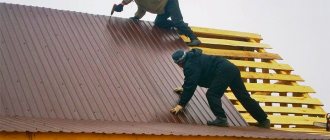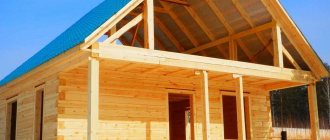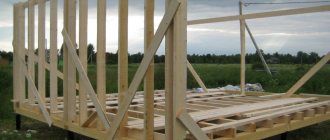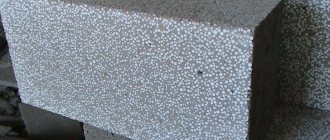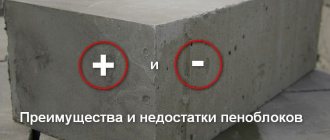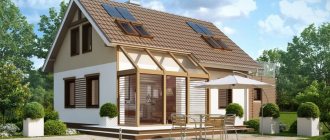No. 1. What is polystyrene concrete made of?
Polystyrene concrete arose as an attempt to produce a building material that would not require additional insulation of the walls from the outside . Polystyrene beads were added to the concrete solution, which provided the material with outstanding thermal insulation properties. The composition of a modern polystyrene concrete block includes cement, sand, water, polystyrene foam granules, special plasticizing and air-entraining additives and sometimes surfactants (surfactants), which increase the adhesion of the concrete solution and foam balls.
Depending on the proportions in which the components for the block were taken, the material can be used for the construction of load-bearing walls, partitions, or as insulation. One block of expanded polystyrene replaces 20 bricks, and accordingly the speed of building construction increases many times over.
Types of polystyrene concrete blocks
Polystyrene concrete comes in different forms. Cheap, low-density material is excellent for thermal insulation, however, it cannot be used to build a house.
Comparison of porosity of polystyrene concrete blocks with others
This polystyrene concrete can serve as a construction aggregate, which is placed as a layer between load-bearing structural elements. Another type of polystyrene concrete has a high density. This is an excellent construction material.
All its disadvantages boil down to the fact that it has a higher price and insufficient strength to be used for the construction of load-bearing structures.
Scope of application for polystyrene concrete
The construction of a residential building with your own hands is progressing at a rapid pace, provided that polystyrene concrete blocks are used. They are used for the following purposes:
- Creation of floor coverings, heated floors, ceilings, attic structures;
- Constructions of facades, architectural forms;
- Raising walls;
- Performing ring masonry;
Construction of a cottage from polystyrene blocks - Devices of jumpers or interior partitions.
No. 2. Pros and cons of polystyrene concrete
Features of the production technology and composition of the blocks allow us to talk about the numerous advantages of the material:
- excellent thermal insulation qualities. According to manufacturers, a wall 20 cm thick will be enough to provide the required heat transfer resistance in regions with mild climates. In regions with harsher winters, a wall 30 cm thick will be needed, but the most common option in this case is 20 cm of polystyrene concrete and foam insulation. The thermal conductivity coefficient of the material depends on the density, but in any case it is several times lower than that of many analogues;
- excellent soundproofing qualities. A 20 cm thick wall can block sound of 72 dB;
- The light weight of the blocks and their large dimensions make it possible to significantly simplify and speed up the work on building a house. There is no need to use complex heavy equipment. Moreover, it is easy to give the blocks the required shape, so in fact, you can build a house from them even with complex architectural elements, however, the consumption of material will increase greatly;
- high resistance to moisture, resistance to mold and rodents;
- high frost resistance. The material can withstand up to 100 freeze/defrost cycles, which is three times more than the same foam concrete;
- the material belongs to the G1 flammability class, i.e. it is practically not flammable. Experiments confirm that after an hour's exposure of a polystyrene concrete wall to a temperature of 10,000C, it does not collapse. True, there is another side to the coin. If a building survives a fire, it will most likely survive, but will become unsuitable for further use, since the walls will lose sufficient strength;
- no shrinkage;
- low load on the foundation;
- acceptable strength;
- the ability to create a monolithic house from polystyrene concrete, without cold bridges;
- low price.
Main disadvantages:
- the low vapor permeability of the material will not allow excess moisture from the room to pass through it, so it is necessary to equip a good ventilation system, otherwise the problem of high humidity and stuffiness inside the house will be ensured;
- complexity of the installation of fasteners. Ordinary nails and self-tapping screws will hold very poorly in a wall made of polystyrene concrete; they can literally be pulled out with bare hands, so you will have to stock up on special anchor bolts designed for this material. On the one hand, such a fastening element is tightened with a nut and washer, on the other, the outer sleeve opens in the form of a petal;
- The quality of the block greatly depends on the accuracy of adherence to production technology. If the ratio of concrete and foam granules has been violated, then the strength of the block will be low, and if there is insufficient adhesion, the granules may even begin to fall out of the block. When purchasing, always inquire about the quality certificate;
- with prolonged exposure to high temperatures, the foam balls burn out, leaving essentially only a concrete frame. Its strength and thermal insulation are not high and do not allow it to be used as an external wall. However, facing the walls with non-flammable materials and high-quality plaster can protect the walls well from fire, and the very ability of the walls to withstand high temperatures is worth a lot, so this drawback cannot be called significant;
- the low density of the material complicates the installation of windows and doors. If you do not take into account the numerous features of the installation, then within a couple of years you may encounter loose fasteners;
- The walls must be plastered. The layer of plaster inside is at least 20 mm, outside – at least 15 mm, and adhesion with the plaster solution is not entirely ideal.
The properties of polystyrene concrete allow it to be considered as a material for the construction of load-bearing walls of a house. It can also be used for the construction of fences, sheds, garages and as a heat insulator.
What is polystyrene concrete
Polystyrene concrete wall blocks
When creating this material, engineers were faced with the task of coming up with a building material for walls that, given its limited thickness, would not require additional insulation, and to make flammable foam plastic safe in this regard. As a result, we got what we have.
The composition of polystyrene concrete includes: Portland cement, expanded polystyrene granules (also known as polystyrene foam), quartz sand, plasticizing additives to reduce the delamination of the mixture and increase its elasticity, as well as water. All together, this gives the material the following positive and negative properties (let's start with the first):
Low Density Polystyrene Concrete Building Blocks
- The material can be operated at a very high temperature range. If we take into account possible differences on the entire planet, then we can say that it has no restrictions at all. Polystyrene concrete can withstand sudden changes very well, which is important.
- Humidity is also not a problem for polystyrene concrete. The presence of polymer granules in the structure greatly reduces the degree of absorption of the blocks, which is especially good for regions with high humidity.
- Due to the fact that moisture practically does not penetrate into the material, its frost resistance also increases. Manufacturers claim that the material can withstand from 150 to 300 defrosting cycles, which, as you understand, is a lot. And what is important, this does not affect its thermal insulation characteristics in any way.
Polystyrene concrete wall blocks - material structure
- The thermal insulation and sound insulation characteristics of expanded polystyrene concrete are at a very high level. What can I say, the creators managed to achieve the desired effect.
- Polystyrene concrete is lightweight, which makes it possible to lay a lightweight foundation under walls and ceilings, which is important for private low-rise construction, as it can significantly reduce material costs.
- You can buy the material in liquid form or prepare it yourself to pour it into the desired shapes. In this way, you can make ceilings and lintels over door and window openings - we’ll talk about this a little later.
- If desired, the building box can be made monolithic using the same liquid mixture - this construction technology is also gaining popularity today.
- Construction from such blocks is much faster than from brick, since they have large dimensions. We also remind you that the material is lightweight, which means you can do without large lifting equipment.
- The material is easily cut with a regular hacksaw, which allows you to fit parts quickly and accurately.
Construction from polystyrene concrete blocks - house from panels
The material has many advantages, but it is not without its disadvantages.
Among their total number, it is worth highlighting the most important:
- Polystyrene itself is moisture and vapor proof . It gives the same property to walls with ceilings made from it. For this reason, moisture gradually begins to accumulate inside buildings, since it simply has nowhere to go. High humidity means a decrease in thermal insulation characteristics, disruption of the microclimate, as well as the possibility of mold appearing on the finish over time.
Advice! The only solution to the problem is proper organization of the ventilation system and frequent ventilation of the room.
Filling the screed with liquid polystyrene concrete
- Polystyrene concrete blocks are not as strong as expanded clay concrete and similar materials . However, in this regard, it is much better than gas blocks, which do not have filler at all. You can hang weights on polystyrene concrete walls, but it is still recommended to use special fasteners.
Dowel for polystyrene concrete blocks
- Polystyrene concrete is a new material, and, despite all the assurances of manufacturers, we can only judge its durability using certain forecasting systems. That is, there are no real examples, and there cannot be.
- There are no accurate toxicity studies , since styrene is harmful and can be released into the surrounding air.
- The fire safety of polystyrene foam blocks has been established, but it is also known for certain that when heated strongly, the polymers in the composition begin to release toxic substances. At the same time, the strength of the material itself is greatly reduced, which means that if a fire occurs, but the building survives, it will still have to be dismantled.
Interesting to know! During testing, polystyrene concrete is kept heated to a temperature of 1000 degrees Celsius, but this still does not lead to complete destruction of the material. The structure is preserved, but, as we have already said, the strength decreases.
No. 3. Monolithic houses made of polystyrene concrete
Polystyrene concrete, like expanded clay concrete, allows you to build houses using monolithic technology. The composition of the material is still the same, only individual blocks are not made from it - it is poured into finished formwork, forming the walls of the house.
The advantages of this solution:
- absence of cold bridges, because there are no seams between the blocks;
- high speed of house construction;
- minimal chance of shrinkage. Polystyrene concrete blocks are not capable of shrinkage - it can occur due to the use of mortar;
- high strength and durability;
- uniform distribution of load on the foundation;
- the ability to integrate some communications into a monolithic wall.
The main disadvantage is the complexity of construction . Since the walls need to be poured in one go, you will need a large amount of mortar and special equipment, so you can’t do it yourself, but you can build a house from blocks yourself.
Types of construction
Formwork for monolithic construction
As in the case of expanded clay concrete, the possibility of block and monolithic construction of the building is available. For the second option, it will be necessary to take care of the correct installation of the formwork in compliance with a certain profile of the components, which will make it possible not only to ensure better weaving, but also to eliminate cold bridges. Blocks can be made at home. This does not require a lot of strength or great skills. Moreover, they can be of different configurations, tailored to a specific project.
Pouring polystyrene concrete
No. 4. Density, strength and frost resistance of polystyrene concrete
GOST R 51263-99 standardizes the main performance indicators of polystyrene concrete. According to it, brands are determined by density from D150 to D600 , where the number means density in kg/m3. The lower the density, the higher the thermal insulation qualities of the material and the lower its strength.
The standard also defines compressive strength classes from B0.5 to B2.5: the higher the coefficient, the greater the load the block can withstand. Also, compressive strength is sometimes designated by the letter M with a coefficient from 2 to 5. This marking is introduced for a material that is designed without taking into account the requirements of ST SEV 1406, its strength is lower.
Frost resistance is determined by the cycles of freezing and defrosting that the unit can withstand, maintaining its basic performance qualities. For polystyrene concrete, frost resistance ranges from F25 to F100 and increases with increasing material density.
Based on density and a number of indicators that depend on it, polystyrene concrete is divided into three classes :
- thermal insulating polystyrene concrete with a density of D150-D200 with low strength and low thermal conductivity coefficient (0.055-0.065 W/m*K). Used for insulation of heat-conducting systems, external walls and ceilings;
- thermal insulation and structural polystyrene concrete with a density of D250-D350 can be used for thermal insulation of non-load-bearing and self-supporting walls. In some cases, D350 blocks can even be used for the construction of external load-bearing walls, provided that the building is low-rise and the external cladding is light;
- Structural thermal insulating polystyrene concrete grades D400-D600 are used for the construction of load-bearing walls of low-rise buildings (up to 3 floors) and non-load-bearing walls of multi-storey buildings. Monolithic buildings are also erected from polystyrene concrete of these brands.
For the basement of the house, blocks with a density of D650-D800 would be suitable, but they are not produced by manufacturers, so it is better to build this element of the house from brick or concrete blocks. It is worth noting that at their own peril and risk, private builders use the D500-D600 block to equip the basement of 1- and 2-story buildings and garages, and during the first 10 years of operation there are no problems with these buildings.
Features of the production process
Do-it-yourself monolithic polystyrene concrete is produced with different technical characteristics. They differ in density and degree of thermal insulation. For the factory version, the characteristics are indicated on the packaging. High strength is ensured through the use of a steel frame. Thanks to him, it is possible to obtain class A III slabs. The choice of rod diameter directly depends on the degree of load exerted on the surface. Attention is paid to his choice. The material has a high load-bearing capacity. This allows it to be used for covering any type of premises. The thickness will be from 115 to 180 mm.
Polystyrene concrete is used to create the following types of floors:
- Installation on corrugated sheets is carried out for a monolithic version.
- When combining a self-leveling and mounting layer, a semi-mounting slab is used.
- The installation option is combined with individual wall elements or load-bearing beams. It is advisable to use slabs for flooring.
The slabs are installed year-round. The process is performed manually or using forklifts. Roofing options do not require plaster. Thanks to this, it is possible to significantly reduce the period of construction work.
No. 5. Types of polystyrene concrete
Polystyrene concrete is produced by manufacturers in the following modifications:
- the wall block is used for laying walls and partitions, has dimensions of 588 * 300 * 188 mm or 588 * 380 * 300 mm;
- the partition block is taller and thinner, has dimensions of 588 * 600 * 92 mm;
- lintel blocks with reinforcement are used, as a rule, for masonry in the locations of window and door structures; they have dimensions of 380*300*1300 mm;
- The polystyrene concrete solution is delivered to the construction site by special transport; it is necessary for the construction of houses using monolithic technology.
Walling
There are several ways to make walls from polystyrene concrete. Different products are used for this, so in this chapter we will simultaneously analyze the types of polystyrene concrete products produced.
Block masonry
Polystyrene blocks of different sizes
Blocks for building a house can be purchased ready-made in the store, or you can cast them yourself. And what’s noteworthy is that the quality of the final products will differ little.
Casting polystyrene concrete blocks in molds
It is prepared in the same way as ordinary concrete, and you can easily find the exact recipe on the Internet.
Interesting to know! Polystyrene concrete does not vibrate for compaction, since polystyrene granules begin to float to the surface, disrupting the structure of the product. This fact means only one thing for us – we will work faster.
The laying process proceeds in the following sequence:
- A layer of waterproofing material is laid on the surface of the grillage or plinth. Usually this is roofing felt, which is glued to the base using bitumen mastic. It is best to lay insulation in two layers to ensure the maximum level of protection from moisture, and this must be done even despite the good resistance of polystyrene concrete to water.
Construction of walls - polystyrene concrete
- Next comes the most crucial and difficult moment in all the work - laying the first row. In fact, you are forming a base on which the evenness of all the walls will depend, so you should get a perfectly straight line, leveled.
- The blocks themselves have good geometry and fit perfectly close to each other. So, the task is to make the seams between them as minimal as possible so that cold bridges do not appear, which will be a thick layer of cement-sand mortar.
- To avoid mistakes, they use the lighthouse masonry method, when blocks are placed in the corners on the same level. A fishing line or thread is pulled tightly between them, serving as a guide.
- The base may have uneven surfaces, so the layer of adhesive mixture will constantly change, sometimes reaching several centimeters. For this reason, for the first row we use only cement-sand mortar, the minimum thickness of which should be 1 centimeter.
Walls made of polystyrene concrete blocks - the thinner the seam, the better
- Further laying is usually done using a special adhesive solution. Why not at the TsPS? It's simple - the glue has high elasticity and does not delaminate after mixing. This leads to a reduction in mixture consumption, plus the seams are minimal. The glue layer is easy to control as it is stretched using a comb.
Polystyrene concrete blocks should be laid using special glue
- Another undeniable advantage of the glue is the presence of additives that increase its frost resistance and water resistance.
Advice! If you are worried that glue is very expensive, then just add up the following facts in your mind. Glue consumption is almost two times less than that of DSP. The composition is already completely ready for use, and all that is required of you is to dilute it with water in the required proportions. The glue retains its working properties for several hours, which means you can easily take long breaks. You don't need a concrete mixer for preparation.
How to lay polystyrene concrete blocks - the material can be easily adjusted to the required dimensions
Further work will be no different from laying any other blocks - we raise the walls row by row.
However, there are some points you should always keep in mind:
- We constantly monitor the evenness of each new row. To apply an even layer of glue, we use a special scraper bucket or a toothed grinder - the first option is preferable.
- When laying the blocks, be sure to compact them by lightly tapping them with a rubber mallet.
- Lay out the window and door openings immediately - cutting them out later is highly discouraged.
- The masonry should be reinforced every 4 rows, and the first row should be the starting row.
- To lay the reinforcement in blocks, it is necessary to make grooves along the entire perimeter of the row, which are then cleaned of dust and filled with liquid glue.
Manual wall chaser
- Polystyrene concrete is a rather fragile material, so the grooves are cut with a device like the one in the photo above. This is done very easily and quickly.
In general, reinforcement is a separate topic, but we will tell its basic rules briefly, since we simply cannot fit into the size allotted for the article.
A bathhouse made of expanded polystyrene concrete blocks is also reinforced
- So, we have already said about the first row and every 4 subsequent ones.
- We place reinforcing belts in the places where the lintels of door and cocoon openings support the lintels, while the outlet on the sides should be at least 90 centimeters.
- The last row must also be reinforced - here it is generally better to make a full-fledged armored belt.
Interesting to know! If the block is up to 20 centimeters thick, then the reinforcement is laid in one row - the grooves are made in the center. For wider models, we make two rows, evenly spaced from the center of the block.
A very important point - the rods must bend in the corners and extend onto adjacent walls by at least 50 centimeters, otherwise there will be no normal connection.
Fiberglass reinforcement
Today, many developers prefer to use fiberglass reinforcement, which is corrosion-resistant, lightweight, does not conduct heat, and can withstand bending and tensile loads well. By the way, the last point can be considered an inconvenience, since the part cannot be bent normally and special sleeves are required for turns.
Polystyrene concrete panels
Polystyrene concrete panels
An innovative solution to the use of polystyrene concrete was the production of dimensional wall panels from it.
- These products allow you to build houses in the shortest possible time.
- At the same time, not only walls are made from them, but also floors, roofs and, imagine, stairs (of course, standard ones).
- The panels have the following structure. Inside the polystyrene core there is a metal reinforcing mesh, to which reinforcement rods are welded, extending in all directions.
- The panel is very durable and surprisingly light in weight - the 3*1.2 meter structure weighs about 20 kilograms.
- After the installation of the panels is completed, the core of the products is covered with a concrete shell 5 centimeters thick. Concrete is applied by shotcrete method.
- The result is a monolithic structure only 25 cm thick, comparable in its characteristics (we are talking about thermal insulation) to a brick wall, the thickness of which should be 1.5 meters.
Just think about these numbers! The houses turn out to be very warm and economical, and a sufficiently thick concrete shell will make the material absolutely invulnerable to fire.
No. 6. What to consider when choosing and purchasing polystyrene concrete?
Recently, a lot of low-quality products have appeared on the market, which is caused by the growing demand for polystyrene concrete. Some companies that previously produced foam blocks have now begun to produce polystyrene concrete, and often attempts to quickly please the market lead to a deterioration in product quality. What should you pay attention to and what should you check when purchasing?
- uniform filling of concrete granules;
- uniformity of granules;
- compliance of the block weight with the specified density;
- when ordering polystyrene concrete, you need to find out as much information as possible about the manufacturer, so you can and should safely ask where the production facilities are located and inquire about the manufacturing features. A normal manufacturer can invite you to production and demonstrate the products, and will also tell you what thickness of walls it is better to make, what density of blocks to choose, advise how best to attach shelves, what adhesives and solutions are best to use when laying - in general, you should answer any question;
- quality certificate is another important point. But even its presence is not always a 100% guarantee of quality. If you are dealing with a distributor and he shows you a quality certificate from the manufacturer, then it doesn’t hurt to check with the manufacturer that he is cooperating with this seller.
Disadvantages of polystyrene concrete
Among the disadvantages of this building material it is worth noting:
- Reduced vapor permeability . This may result in increased humidity indoors;
- Complexity of fastening elements . Conventional self-tapping screws are unlikely to work here. Developers most often use anchor bolts, in which the sleeve on the outside resembles a petal;
- Dependence of material quality on production technology . If the latter is violated, polystyrene concrete blocks will not be durable. The certificate confirms that the products comply with GOST requirements. Be sure to check it when purchasing material;
- Severe damage from prolonged exposure to high temperatures . Polystyrene concrete blocks do not burn, but they lose their strength when heated for a long time;
- Polystyrene concrete is not easy to build with . Developers often have similar problems with the installation of door panels and windows (distortions). Due to the period required for the material to harden, walls and other structures must be created in one go;
- Availability of restrictions on thawing and freezing cycles . The shelf life of the material is long, but by no means eternal;
- Reaction to ultraviolet rays . Styrofoam balls, when exposed to direct sunlight for a long time, tend to break down.
No. 7. Large manufacturers of polystyrene concrete, or who can you trust?
The choice of manufacturer can be called the cornerstone in the construction of a house made of polystyrene concrete. There are many of them in the country, but among the largest enterprises we will name the following:
- BlokPlastBeton LLC is a subsidiary of a large manufacturer of building materials, GradStroy LLC. Modern equipment is used here, production is carried out in compliance with all technologies. Polystyrene concrete blocks up to D500, heat-insulating slabs and reinforced lintels are produced. Delivery is carried out by road throughout the European part of Russia;
- Polystyrene Concrete Plant LLC was founded in 2001 and over the years has proven itself very well. Polystyrene concrete is used to produce floor slabs, wall panels, blocks, reinforced lintels and mortar. All products are certified. The company is located in the Sverdlovsk region, but delivery is carried out throughout Russia;
- Polystyrene concrete-SPb LLC offers polystyrene concrete blocks with densities from D200 to D500 and partitions with densities from D. The company has all test reports and relevant certificates;
- LLC "WARM CONCRETE" is a responsible Novosibirsk manufacturer that offers polystyrene concrete in the form of blocks, lintels and mortar for monolithic construction technology. The material is produced with a density of D200-D. The products are widely used by private and large developers;
- Baustoff-Polystyrene Concrete LLC is a Krasnodar company that produces blocks and reinforced lintels made of polystyrene concrete, the quality of products is constantly improving, production is being modernized.
Advantages of polystyrene concrete
Due to its unique composition and technology, expanded polystyrene has the following advantages:
- Resistant to low temperatures . The material is not afraid of the cold and feels great in the harsh Russian winters;
- Impressive parameters and low weight of blocks . Which allows you to significantly save on delivery and loading/unloading operations;
- Almost complete fire safety;
- No need to install cold bridges . Due to the high thermal insulation properties of the material;
- Budget cost and versatility;
- Durability of construction and minimal shrinkage . True, durability is lower than that of brick, and the degree of shrinkage depends on the selected weight of the blocks;
- No difficulties when implementing communications;
- Environmental friendliness;
- Unpretentious care.
Transportation of expanded polystyrene and the installation process are also not difficult. This is explained by the fact that the product is characterized by lightness and massiveness.
The service life of polystyrene concrete is unlimited. If the correct construction algorithm is followed, the house will meet all requirements.
No. 8. DIY polystyrene concrete
You can make polystyrene concrete blocks with your own hands. The more carefully you follow the technology, the more durable and durable the products will be in the end. The set of components for making blocks is simple. You will need cement, sifted sand, water and polystyrene granules. Instead of concrete, a gypsum mixture is sometimes used as a base. You can also add special modifying substances to the mixture, for example, an air-entraining additive or even tar to increase moisture-resistant qualities.
The proportions of the components depend on what kind of block is planned and what the emphasis is on, thermal insulation or strength. The larger the cement portion, the stronger the resulting block will be. The following proportions are suitable for a structural and thermal insulation block: 1 bucket of cement, 3 buckets of sand, 6-8 buckets of polystyrene granules, slightly less than 1 bucket of water. The sequence is:
- Pour water into a concrete mixer or a stationary mixer, add all the additives and half of all granules so that the cement sticks less to the walls. Water can then be added to achieve the required consistency;
- cement is added, the mixture is stirred until smooth;
- add sand and the rest of the polystyrene, mix everything well, the required consistency of the solution is dry, this will make it easier to work with the molds;
- pouring into molds. As such, you can use a metal box, which is independently welded from sheets of metal 3 mm thick. You can use a matrix mold made from old boards, but it is important to lubricate the mold with machine oil. The solution is well compacted from above, you can turn on vibration for 2-3 seconds, but no more - prolonged vibration violates the integrity of the blocks;
- The blocks are removed from the metal mold, and from the wooden ones too, but you can leave them inside the mold for a day. The products are left to dry for 24 hours in a warm place, the temperature is above +150C, you can cover them with plastic wrap. After 4 weeks, the blocks gain the necessary strength for construction.
How to choose high-quality polystyrene concrete?
To purchase a product that meets all standards, you need to consider several factors. Among them are:
- uniform distribution of granules in the concrete solution;
- size of foam balls;
- correspondence between the density of the composition and its weight.
When purchasing polystyrene concrete, you should pay attention to the manufacturer and the features of the production process. Lack of experience is a good reason to turn to specialists. They will tell you the optimal density and thickness of the panels suitable for your future home.
No. 9. Features of building a house made of polystyrene concrete
Building a house is a complex multi-stage process that requires at least basic specialized knowledge. In general terms, building a house made of polystyrene concrete looks like this:
- foundation arrangement. Since the overall weight of the structure is small, a columnar, shallow strip or pile foundation can be used. For complex types of soil, it is better to choose a screw pile;
- walling according to the chosen technology: from blocks, with removable or permanent formwork. Building with blocks begins with waterproofing work and determining the highest place from which the laying of walls begins. When laying, verticality and horizontality are strictly observed using a fishing line and a level. To increase strength, reinforcing mesh can be laid horizontally. If blocks with solid voids are used, vertical reinforcement is performed. The thickness of the mortar seam is no more than 8 mm; it is better to use special glue. Monolithic walls They are erected using removable formwork made of 15 mm thick plywood, which is protected from moisture with a polyethylene film. The plywood is held in place through the use of metal profiles; they are attached to the foundation with self-tapping screws or dowels. Sheets of plywood are attached to the profiles; first, external partitions are created, then internal ones. When pouring, the solution compacts well; the formwork can be dismantled after a few days. Instead of plywood, you can use brick walls - this permanent formwork, in this case, facade cladding will not be required;
- ceiling made from special polystyrene concrete panels or also by pouring. Floor screeding is performed using standard methods;
- exterior finishing of a house made of polystyrene concrete is necessary. You can use decorative brick, siding, and plaster. Inside, you also first need a layer of plaster, then putty, and then whatever you want: wallpaper, painting, decorative plaster.
A house made of polystyrene concrete can be built in a matter of months, and if all the features of the technology are observed, it will stand for decades. Most importantly, do not forget about high-quality ventilation and specific fasteners.
The article was written for the site.
Tags: Foam block and gas block, construction
Phased construction of a polystyrene concrete house
Wall blocks made of polystyrene concrete - ready for work
So, you’ve probably already decided for yourself whether this material is right for you. And if you told him yes, then you can count on the construction of the structure in just 3-4 weeks (not counting the foundation), if you work without breaks and with a friendly team.
Foundation structure
The beginning of any construction is laying the foundation, and, as we have already said, it can be lightweight for a polystyrene concrete house.
You can choose the appropriate option for yourself from the following types:
Pile foundation - birch logs are used only as supports for the formwork
- Pile foundation - reinforced concrete and metal options are suitable;
Columnar foundation with a grillage made of metal channel
- Columnar foundation;
Pouring a strip foundation with channel logs
- Strip foundation is the most material-intensive solution.
You need to choose the type of foundation taking into account the characteristics of the soil on which you will build and the climatic conditions in your place of residence.
This foundation will last an incredibly long time.
- The most universal solution in this case is the use of a pile foundation, since it can be used on almost any type of soil. It is especially advantageous to take the metal version, since it can be installed in just a couple of hours, scalded with a grillage made from a channel, and immediately begin building walls.
- The second in speed and convenience will be a columnar foundation, and the most extended in time will be the strip version, since although the concrete in it may be of a low class, it still requires 28 days to gain its strength.
Pile tying options
- The speed of installation of columnar and pile foundations will also depend on the type of grillage used. In some cases, it is made of reinforced concrete, which similarly extends the work over the already announced period.
Formwork for a concrete grillage on metal piles
Let's take that same pile foundation as an example and find out the procedure for its installation:
- The first step is to clear the site for future construction. It is necessary to level it and remove the turf - the plant layer - from it.
The markings must be correct, otherwise the walls of the house will be crooked
- Next, precise markings are made using pegs and threads stretched between them. The main markings should follow the outline of the house. All angles are made right unless otherwise planned, which can be achieved by using the Pythagorean theorem about the legs and hypotenuse, as well as checking the length of the diagonals, which must be equal.
- According to the power of the future grillage and the piles themselves, we place marks for the places where the piles will be screwed in. It is difficult to make such a calculation without the necessary preparation, so without a project you have to use common sense, often playing it safe. A step of 1.5-2 meters is usually sufficient.
Installation of screw piles
- Next, at the marked points, the piles are screwed in to the required depth, which depends on the depth of soil freezing in the region. Installation can be done manually, as shown in the photo above, or you can use the services of special equipment for a fee. The price for the work is not that high, so if you want to speed things up as much as possible, we use such services.
Trimming piles to level
- Depending on the terrain, the piles can be screwed in to different heights, so after installation they need to be cut to the same level. We mark it with a laser axle builder or everyone’s favorite hydraulic level.
- Cutting is done with a grinder.
Advice! All piles must be installed strictly horizontally, therefore, at the moment of screwing, be sure to control their position with a level.
The result is satisfactory
- Next comes the turn of installing the grillage. We have already attached a diagram with all possible options, so choose the most optimal one for yourself - in our opinion, this is a metal channel that can be welded on in the shortest possible time, and you can immediately continue working.
Many people often ask the question: is it possible to lay a plinth made of polystyrene concrete blocks? In the case of building a house, the answer will be negative. The base is the above-ground part of the foundation, and the strength of polystyrene concrete will not be enough for it.
For these purposes you can use:
- Heavy concrete (FBS blocks);
- Expanded clay concrete blocks;
- Red brick;
- Rubble masonry;
- Rubble concrete;
- Reinforced concrete;
However, there is still the option of using polystyrene concrete blocks for the foundation and plinth, but only as permanent formwork.
Block for permanent formwork
And to be completely frank, such a plinth can be laid out under a very light structure - for example, if a bathhouse is being built from polystyrene concrete.
Bathhouse made of polystyrene concrete blocks
Making polystyrene concrete at home
So, having become familiar with the basic properties of polystyrene concrete and its scope of application, let’s consider how this building material can be made at home, without significant loss of quality. But first, you need to decide what you need it for, since the manufacturing technology may differ in each case.
Recipe for making polystyrene concrete
Polystyrene concrete is used:
- When insulating the roof and attic.
- For pouring monolithic walls of a house.
- For making blocks.
In both cases, you need to make a high-quality solution, the strength of which will allow you to obtain the desired result. For the attic, you can make a less durable solution, so this point will be described separately.
The table below shows the proportions for obtaining 1 m3 of polystyrene concrete of different densities.
- The first step is to properly prepare a solution of saponified tree resin (STR) in a liter jar by pouring boiling water over it.
- The resin dissolves until smooth.
- Instead of resin, you can use liquid soap or detergent, but in this case the thermal insulation properties of the material deteriorate.
- 10 liters of water are poured into a concrete mixer and a plasticizer is added.
- Having started the concrete mixer, we pour some of the polystyrene into it.
- Add the required amount of cement and water, mix the solution until a homogeneous composition is obtained.
- Lastly, the rest of the polystyrene is poured. After mixing, the solution is ready for intended use.
Attic insulation
To insulate the attic, the mixture is prepared as follows:
- A trough is installed right in the attic and 3 buckets of polystyrene are poured into it.
- Then 1.5 liters of water is poured into this container with 30 ml of detergent or liquid soap added to it.
- Mix everything so that the balls are moistened with water.
- A bucket of M400 cement is added, and everything is mixed again with a mixer.
- As mixing progresses, water is added.
The finished mixture is used to insulate the attic, laying it in a layer of approximately 10 cm.
As you can understand, it is not difficult to make polystyrene concrete at home, but in order for it to correspond to a certain brand, it is important to maintain proportions when making it. It is important to take into account that the higher the strength of the material, the lower its thermal insulation properties, and vice versa.
In a short article it is impossible to describe all the methods for producing polystyrene concrete, and this is not necessary. If you have your own developments and experience in this area, then your comments will be an excellent addition to the material already presented.
